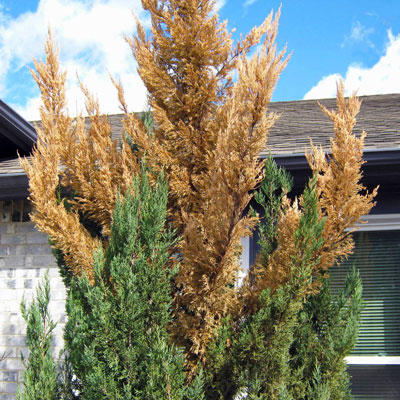Question of the Week – Number 2: May 7, 2020
“Why are junipers dying one or two branches at a time? Can they be sprayed to save them? Can they be pruned?”
This dieback of junipers has been an enigma for me since my own Table Top Blue juniper started losing small twigs at the ends of each of its branches every spring. I finally got so tired of it that I just replaced the plant with another type of plant entirely (holly, of course).

And then I lost two beloved Spartan junipers, one at my office and one at our house, but they died one long branch at a time. I couldn’t trim them because the pruning cuts would have left big gashes in each of the plants.
That was way back, years before Internet searches, and I couldn’t figure out what had hit my junipers. But now I know. The blight of the small twigs on my Table Top Blue was Phomopsis blight (Phomopsis juniperovora) that is a spring problem on the new growth, especially during cool, moist springs like the one we’ve just been through.
My Spartans were killed by a different fungus, Kabatina juniperi, so named because it’s a big problem for many types of junipers, most notably Blue Point as well as Spartan. It attacks the older shoots one year and older, and it shows up in the summer.

How do you deal with these two?
That’s the bad news. There is no fungicide, at least that’s available to consumers, that will help with these diseases. Nor is there is preventive treatment. Nor are there very many varieties of junipers that are resistant. That’s why I switched over to hollies.
So I wish I had a prettier song to sing for you, but facts are facts. These diseases have the upper branch.
Note: Here is a scholarly fact sheet from the University of Maryland from experts whose opinions carry more weight on this topic than mine.
